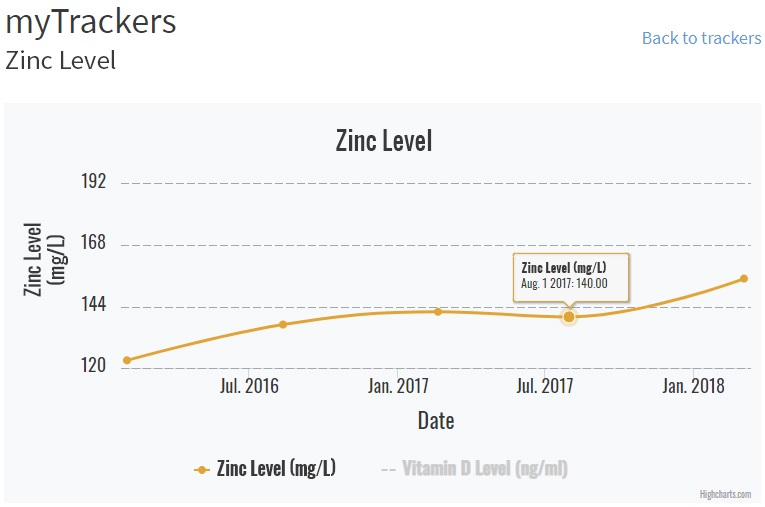Published on February 12, 2019

D*action Magnesium + Safety is a new project from GrassrootsHealth to provide you with information about your nutrient status for many essential elements and toxins. In previous blogs we discussed what magnesium is, why it’s important for health, and how magnesium status is assessed. We also previously discussed selenium, the second element in the testing panel. Today we will talk about the health benefits of zinc, the third essential element in this testing panel.
What is zinc?
Zinc is a mineral present naturally in a wide variety of foods, including red meat, poultry, pork, beans, nuts, whole grains, dairy products, fortified cereal, and some seafood such as oysters, crab, and lobster. While zinc is present in many foods, more is absorbed from animal-based foods because plants and grain have phytates which are compounds that bind to zinc and other minerals and slow their absorption. Zinc is also available as a dietary supplement in multiple forms, such as zinc gluconate and zinc sulfate, and is also found in over-the-counter cold medicines. Daily intake of zinc is important since zinc is not stored in the body.

Why is zinc important for health?
Zinc is a key cofactor for approximately 3,000 proteins and enzymes in the body. It is involved in protein synthesis, DNA synthesis, and cell division. Zinc is necessary for growth and development, sense of taste and smell, wound healing, and central nervous system function. Similar to vitamin D, zinc is important for immune function and bone metabolism. Specifically, zinc helps your body fight infection by promoting the production of white blood cells and helps strengthen bones by stimulating osteoblasts (cells that form bone) and inhibiting osteoclasts (cells that break down bone). Zinc deficiency causes loss of appetite, increased susceptibility to infectious diseases, growth retardation, diarrhea, hair loss, and other symptoms.
Is zinc deficiency common?
An estimated two billion people worldwide are affected by zinc deficiency. While severe zinc deficiency is rare in the United States, mild deficiency due to inadequate intake or absorption problems is more common. Individuals at a higher risk for zinc deficiency include those with digestive disorders that limit absorption, such as Crohn’s disease or ulcerative colitis, as well as those with chronic liver disease, chronic renal disease, diabetes, and other chronic illnesses. Since zinc from plant-based foods and grains are less bioavailable, vegetarians also have a higher risk of zinc deficiency. Additionally, breast milk typically does not provide enough zinc for infants aged 7-12 months so they should also consume zinc-containing foods or formula. The recommended daily allowance (RDA) for zinc is 11 milligrams (mg) per day for adult males and 8 milligrams (mg) per day for adult females (11 mg/day is recommended for pregnant women and 12 mg/day is recommended for mothers who are breastfeeding).
Can I consume too much zinc?
Yes! While some zinc is essential to the body, only small quantities are needed and excess zinc can be toxic. Symptoms of zinc toxicity include nausea, vomiting, abdominal cramps, loss of appetite, diarrhea, and headaches. High zinc intakes can also lead to a copper deficiency. The tolerable upper intake level for zinc is 40 milligrams per day (mg/day) for adults.
How is zinc measured in the body?
Zinc nutritional status can be assessed with a dried blood spot test. This test measures the amount of zinc within the red blood cells as well as within the serum, and for this reason, can be more accurate and detect deficiencies earlier than a typical zinc test of the serum alone. The lab reference range is 5.37 to 7.94 milligrams per liter (mg/L), which is the range of the average population the lab serves.
Order your D*action Magnesium + Safety test TODAY! — includes Zinc test
How can I track my zinc intake and level?
To help you track your supplement use and nutrient levels, GrassrootsHealth has created an online tracking system called myData-myAnswers. For each specific supplement, you can track what days you take it, how much, and many other details. You can also track your zinc intake from dietary sources. This will help you know the intake amount you need to reach optimal levels and how your nutrient status impacts your health. Check it out today!
NEW Magnesium Plus Elements Blood Spot Test, to test Magnesium (RBC test), other elements and heavy metals and vitamin D!
The D*action Magnesium + Safety Project will provide information about the following
Essential Elements
Magnesium
Selenium
Zinc
Copper
Heavy Metals, which can be unsafe for you
Cadmium
Lead
Mercury
and Vitamin D
Join the D*action Magnesium + Safety Project TODAY!
Take Charge of YOUR Health.







